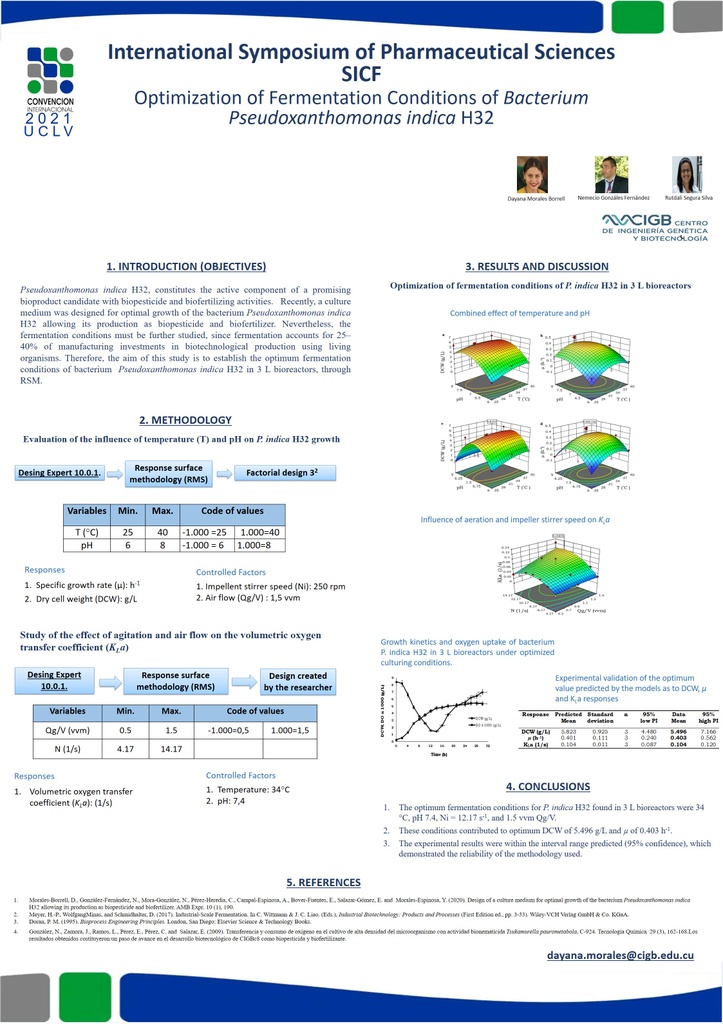Executive Secretary

Simposio Internacional de Ciencias Farmaceúticas
SICF

Abstract
Pseudoxanthomonas indica H32, constitutes the active component of a promising bioproduct candidate with biopesticide and biofertilizing activities. However, suitable fermentation conditions should be established to manufacture this product. Accordingly, the aim of this study was to optimize the fermentation conditions of bacterium Pseudoxanthomonas indica H32 in a 3 L bioreactor. The relevant parameters for strain growth, temperature (25–40 ◦C) and pH (6–9), were optimized using the response surface methodology (RSM). Additionally, the influence of air flow (0.5–1.5 vvm) and impeller stirrer speed (4.17–14.17 s - 1) in the volumetric oxygen
transfer coefficient (KLa) were evaluated and then, in the P. indica H32 growth. The response variables were dry cell weight (DCW) and specific growth rate (µ). The results showed that P. indica H32 growth was significantly affected by the culture medium pH (p < 0.005). The optimum pH and temperature values were found at 7.4 and 34 ◦C, respectively. The conditions that increased KLa, were 12.17 s - 1 and 1.5 vvm, with a KLa value of 0.104 s - 1. This conditions ensured optimum strain growth of 5.496 g/L of DCW (5.E10 10 CFU/mL), whereas µ was 0.403 h - 1. The findings of this study are a step forward in the development of P. indica H32 as biopesticide and biofertilizer.
Resumen
Pseudoxanthomonas indica H32, constituye el componente activo de un candidato a bioproducto prometedor con actividad biopesticida y biofertilizante. Sin embargo, se deben establecer las condiciones de fermentación adecuadas para la fabricación de este producto. En consecuencia, el objetivo de este estudio fue optimizar las condiciones de fermentación de la bacteria Pseudoxanthomonas indica H32 en un biorreactor de 3 L. Los parámetros relevantes para el crecimiento de la cepa, temperatura (25–40 ◦C) y pH (6–9), se optimizaron utilizando la metodología de superficie de respuesta (RSM). Además, se evaluó la influencia del flujo de aire (0,5–1,5 vvm) y la velocidad del agitación del impelente (4,17–14,17 s - 1) en el coeficiente volumétrico de transferencia de oxígeno (KLa) y luego, en el crecimiento de P. indica H32. Las variables de respuesta fueron el peso de células secas (DCW) y la velocidad de crecimiento específica (µ). Los resultados mostraron que el crecimiento de P. indica H32 se vio afectado significativamente por el pH del medio de cultivo (p <0,005). Los valores óptimos de pH y temperatura se encontraron a 7,4 y 34 ◦C, respectivamente. Las condiciones que incrementaron el KLa, fueron 12.17 s - 1 y 1.5 vvm, con un valor de KLa de 0.104 s - 1. Estas condiciones aseguraron un crecimiento óptimo de la cepa de 5.496 g/L de DCW (5.E10 10 CFU/mL), mientras que µ fue de 0.403 h - 1. Los hallazgos de este estudio constituyeron un paso de avance en el desarrollo de P. indica H32 como biopesticida y biofertilizante.
About The Speaker

Ing. Dayana Morales

